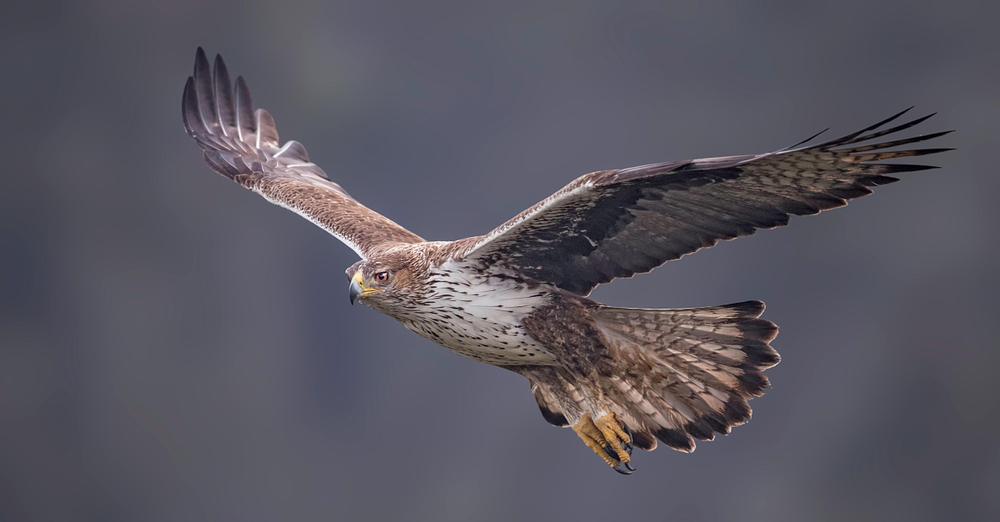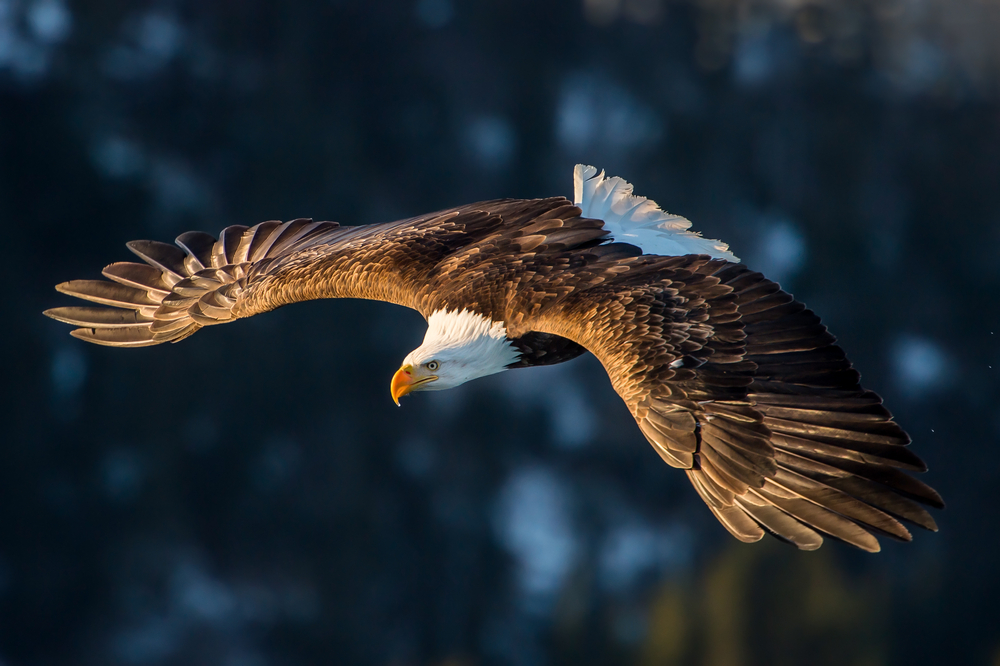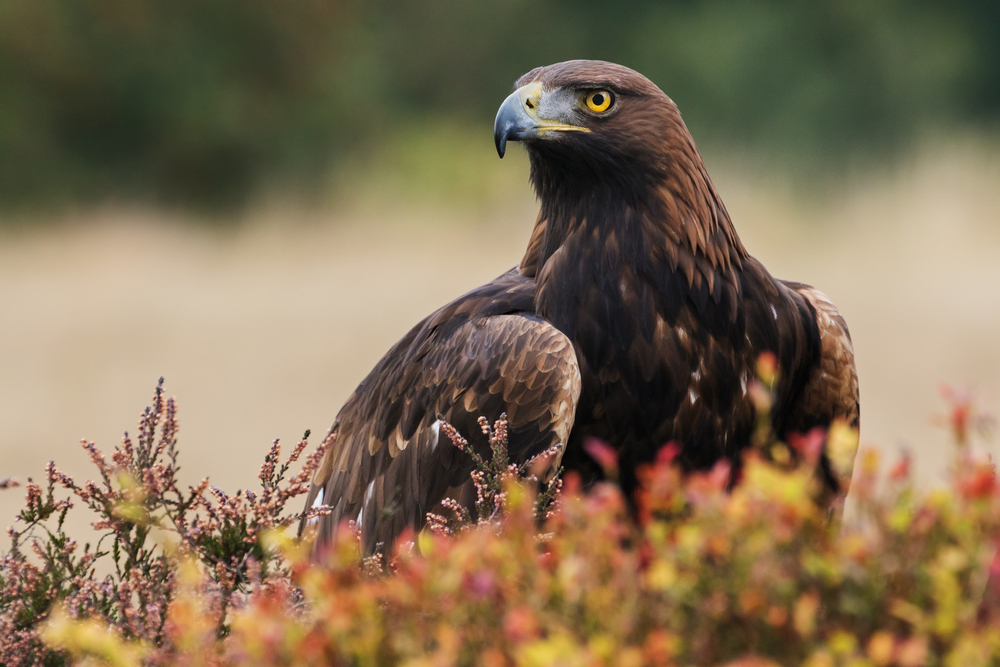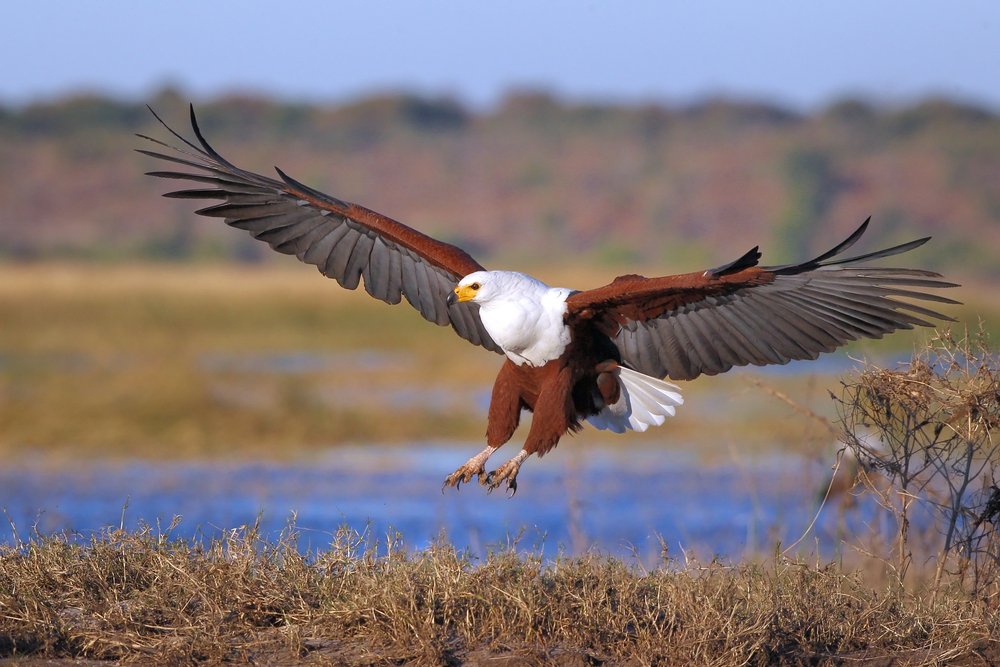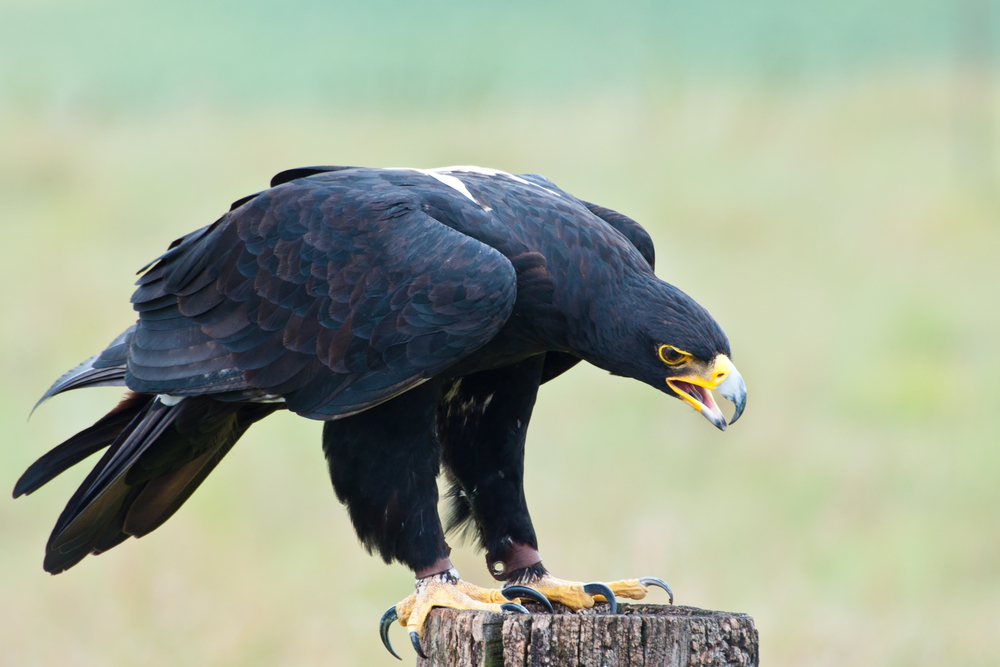The closest relatives of the Bonelli’s Eagle are other members of the genus Aquila, particularly the African Hawk-Eagle (Aquila spilogaster), which shares many physical and behavioral traits. Both are thought to have diverged from a common ancestor and are sometimes considered part of a superspecies.
About
The Bonelli’s Eagle is a powerful bird of prey found across parts of southern Europe, the Middle East, and South Asia. It is admired for its agility, strength, and striking plumage, which features a dark brown back, white underparts with dark streaks, and bold markings on the wings and tail. This medium-to-large eagle is highly territorial and often associated with rocky hills, cliffs, and wooded valleys, where it nests and hunts with precision.
Adult Bonelli’s Eagles typically measure 60–75 cm (24–30 in) in length, with a wingspan of 150–180 cm (5–6 ft). They are strong, swift hunters, preying on medium-sized birds and mammals such as pigeons, rabbits, and hares. Their hunting technique often involves high soaring followed by sudden, rapid dives to capture prey. Known for their fierce defense of nesting sites, these eagles usually build their nests on cliffs or tall trees, where they can safely raise their young away from predators.
Breeding usually takes place in late winter or early spring. Females lay one to three eggs, and both parents share in raising the chicks. The young fledge after about 60 days but may remain dependent on their parents for several more weeks. In the wild, Bonelli’s Eagles can live up to 20 years, though survival rates are strongly influenced by habitat quality and prey availability.
The scientific name of the Bonelli’s Eagle is Aquila fasciata, and it belongs to the family Accipitridae, which also includes hawks, kites, and other eagles. While their global population is considered stable, localized declines have been recorded due to habitat loss, hunting, and disturbance near nesting areas. Conservation efforts focus on protecting breeding sites and maintaining healthy prey populations. As a symbol of power and adaptability, the Bonelli’s Eagle remains one of the most respected raptors across its range.
Physical Characteristics
Bonelli’s Eagle (Aquila fasciata) is a medium-to-large bird of prey known for its powerful build and striking plumage, adapted for hunting in rugged habitats across southern Europe, Africa, the Middle East, and Asia.
Plumage:
Adults display a dark brown upper body with contrasting white underparts streaked with dark markings. The tail is gray with a broad black band near the tip, a key identification feature. Juveniles are paler overall, with golden-brown tones and less distinct markings.
Head and Face:
They have a pale head with a sharp, hooked beak designed for tearing flesh. Their eyes are piercing yellow to amber, giving them an intense, alert expression.
Body and Wings:
Bonelli’s Eagles have a slender yet muscular body with broad wings that taper toward the tips, allowing for agile flight in rocky, forested, or mountainous regions. Their long tail provides excellent maneuverability in confined spaces.
Size:
-
Length (Body): 23 to 29 in (60 to 74 cm)
-
Wingspan: 57 to 71 in (150 to 180 cm)
-
Tail Length: 10 to 12 in (25 to 30 cm)
Weight:
-
Males: 3.3 to 4.4 lbs (1.5 to 2 kg)
-
Females: 4.4 to 6.6 lbs (2 to 3 kg), making them noticeably larger than males.
The Bonelli’s Eagle’s contrasting plumage, long tail, and agile flight distinguish it from other eagles and make it a formidable predator in its diverse range.
Reproduction
The reproductive cycle of Bonelli’s Eagle reflects its life as a territorial raptor, with strong pair bonds and high parental investment.
1. Mating and Courtship:
Bonelli’s Eagles form monogamous pairs, often staying together for life. Courtship involves spectacular aerial displays, including soaring, diving, and talon-locking flights. Pairs defend large territories, reusing the same nesting sites year after year.
2. Nesting:
Nests are built on cliff ledges or tall trees, constructed from sticks and lined with green foliage. Pairs may maintain multiple nests within their territory, alternating between them in different years.
3. Egg-Laying:
The female usually lays 1 to 3 eggs, most commonly 2, between late winter and early spring. Eggs are whitish with variable brown markings.
4. Incubation:
Incubation lasts about 37 to 40 days, primarily carried out by the female, while the male provides food.
5. Raising Chicks:
Chicks hatch covered in white down and are brooded intensively for the first two weeks. They are fed by the parents with freshly caught prey. Sibling rivalry is common, with the stronger chick often outcompeting the weaker one.
6. Fledging and Independence:
Young eagles fledge at about 55 to 65 days of age but remain dependent on their parents for another 8 to 12 weeks as they learn to hunt. Full independence occurs in late summer.
The reproductive strategy of Bonelli’s Eagles emphasizes high parental care, long dependency, and low clutch size, typical of large raptors whose survival depends on skilled hunting and secure territories.
Lifespan
Bonelli’s Eagle is a long-lived raptor, with survival depending on secure territories, prey availability, and protection from human pressures.
Lifespan in the Wild:
In their natural habitats, Bonelli’s Eagles typically live 12 to 16 years, though some may survive up to 20 years under favorable conditions. Mortality is highest among juveniles, especially during the first year after fledging, when hunting skills are still developing.
Lifespan in Captivity:
In protected environments such as aviaries or conservation centers, Bonelli’s Eagles may live 25 to 30 years thanks to veterinary care, consistent food supply, and safety from natural threats.
Threats to the Bonelli’s Eagle:
-
Habitat Loss: Expansion of agriculture, urbanization, and infrastructure reduces suitable nesting and hunting areas.
-
Electrocution and Collisions: Power lines are a major source of mortality for this species.
-
Persecution: Historically persecuted by humans due to perceived threat to livestock and game species.
-
Food Scarcity: Declines in prey such as rabbits and partridges can reduce breeding success.
-
Juvenile Mortality: Intra-sibling aggression and early hunting inexperience contribute to high chick and juvenile losses.
Care and Protection:
Conservation measures include nest protection, habitat preservation, prey management, and insulating power linesto reduce electrocution risks. These efforts are essential to stabilize and extend the lifespan of wild populations.
The Bonelli’s Eagle’s long lifespan, combined with low reproductive output, makes the species especially vulnerable to environmental pressures, underscoring the importance of conservation for its continued survival.
Eating Habits
Bonelli’s Eagles are powerful carnivorous raptors, relying on speed, agility, and strength to capture a wide range of prey.
Diet:
Their diet is diverse but typically includes medium-sized birds and mammals. Common prey species are rabbits, hares, pigeons, partridges, corvids, and occasionally reptiles. In some regions, birds make up the majority of their diet, while in others, mammals dominate depending on availability.
Hunting Strategy:
Bonelli’s Eagles are diurnal hunters, active during daylight hours. They employ both soaring and perch-hunting techniques:
-
From the air, they patrol territories or soar high before stooping rapidly on prey.
-
From perches, they wait patiently, scanning for movement before launching swift, direct attacks.
Killing Technique:
Prey is typically caught with their strong talons in a sudden, high-speed strike. Smaller animals are killed instantly by impact, while larger prey may be subdued with repeated blows from their talons and sharp beak.
Feeding Behavior:
They often hunt alone or in pairs. When hunting in pairs, one eagle may flush prey toward the other for a more successful catch. Once captured, prey is carried to a perch or nest and torn apart with their hooked beak.
Special Considerations:
-
Opportunistic Feeding: They adjust diets to local prey populations, shifting between birds and mammals.
-
Juvenile Training: Parents provide live prey to young after fledging to help them develop hunting skills.
-
Competition: They may scavenge occasionally but are more often displaced from kills by larger raptors like Golden Eagles.
Bonelli’s Eagles’ adaptable diet and varied hunting techniques make them versatile predators, capable of thriving in diverse habitats ranging from cliffs and forests to open plains.
Uniqueness
The Bonelli’s Eagle is one of the most distinctive raptors of Eurasia and North Africa, admired for its agility, striking plumage, and ecological importance.
Contrasting Plumage:
Bonelli’s Eagles are notable for their dark upperparts and pale, streaked underparts, combined with a gray tail tipped with a bold black band. This crisp contrast makes them highly recognizable in flight.
Agile Flight:
With long tails and relatively narrow wings, they are built for speed and maneuverability. Unlike bulkier eagles, Bonelli’s can twist and dive through cliffs, woodlands, and rugged terrain with remarkable precision.
Cultural Legacy:
In parts of the Mediterranean and Asia, the Bonelli’s Eagle has been revered as a symbol of strength and hunting prowess, often appearing in folklore and heraldry.
Ecological Role:
As apex predators, they help regulate populations of rabbits, pigeons, and partridges. This makes them vital to maintaining balance in ecosystems where smaller prey species can quickly overpopulate.
Conservation Concern:
Despite their adaptability, Bonelli’s Eagles are considered Vulnerable in some regions due to habitat loss, prey declines, and high juvenile mortality. Conservation projects often focus on insulating power lines, protecting nesting cliffs, and managing prey populations to secure their survival.
The Bonelli’s Eagle’s combination of contrasting plumage, unmatched agility, and symbolic importance makes it one of the most unique and captivating eagles of the Old World.
Be the First to Share Photos of This Species.
FAQ’s
1. What is the closest species to the Bonelli’s Eagle?
2. How does the Bonelli’s Eagle compare to other eagles?
Bonelli’s Eagles are smaller and more agile than larger species like the Golden Eagle. With a long tail and narrower wings, they are adapted for high-speed chases through rugged terrain, unlike soaring specialists such as the White-tailed Eagle. Their plumage contrast—dark above and white streaked below—sets them apart visually from many uniformly brown eagle species.
3. What national parks provide the best chance to see a Bonelli’s Eagle?
Bonelli’s Eagles inhabit southern Europe, North Africa, the Middle East, and South Asia. Some of the best places to see them include Doñana National Park (Spain), Crete’s Samaria National Park (Greece), Kalatop-Khajjiar Wildlife Sanctuary (India), and Souss-Massa National Park (Morocco), where they nest in cliffs and hunt in open woodlands.



































































